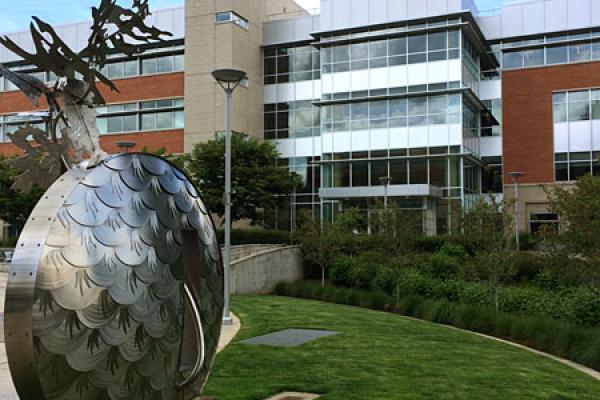We are happy to aid in the development of refuse and recycling enclosure(s) that meets our standards, including the size and placement. We can connect you with the solid waste collector in your area and are glad to share sample plans. Please contact us at 503-557-6363 or wasteinfo@clackamas.us to discuss your site’s needs and limitations before you spend time and money on detailed drawings.
Process
See Zoning and Development Ordinance (ZDO), Section 1021
Step 1: Design review pre-application meeting
In this informal discussion, county staff (including a Sustainability & Solid Waste staff member) and appropriate service providers (e.g., water, fire, sanitary sewer, surface water) provide information and requirements to help applicants fine-tune their project plans.
Step 2: Make updates
If the project goes forward and is deemed feasible by county staff and the Design Review Committee, the next step for the applicant is to revise the site plan to meet any conditions of approval. Typically, one of the conditions will be to "meet the requirements relative to refuse and recycling enclosure(s)" and get a "sign off" from Sustainability & Solid Waste staff.
Timing
It is important to communicate early in the design process since a failure to meet ZDO Section 1021 can delay the issuance of a final Certificate of Occupancy. Failure to meet the requirement also may result in a request to rebuild the enclosure.
Basic Requirements
- Size and access
Developers must consider the size of containers and receptacles that will be required, and service vehicle accessibility to the enclosure.
Service trucks are usually large (approximately the size of fire trucks) and they make frequent trips. A service truck must be able to get to the enclosure, pick up the appropriate containers (without requiring staff to move all the containers and receptacles) and leave the site with a minimum of backing up. (Clackamas County Zoning and Development Ordinance (ZDO) Section 1021 provides details.) - Building materials
Masonry, brick, or chain link and slats -- there is a variety from which to choose. The idea is to eliminate or reduce the visual impact of the containers. - Pad
The enclosure pad must be Portland cement concrete and poured on level ground. Concrete can hold more weight and take more abuse than asphalt. - Gates, bumpers and "no parking" signs
Gates must open fully and be free of obstructions. Gate doors must be able to be locked in the open position. Interior bumpers protect the enclosure from container impacts. "No parking" signs and striped curbs help keep the enclosure accessible to collection vehicles.
What to Avoid
- Inadequate size
If the enclosure is too small, people tend to leave bins outside, which is not allowed. If the containers are jammed inside a small enclosure, it is very difficult for collection staff to remove them for trash and recycling collection.
A larger enclosure provides room to store more recyclable materials. Because unlimited recycling is free with trash service, this can save a great deal of money. - Poor siting
An enclosure at the end of an alley or in a place without adequate maneuvering room for service vehicles creates a dangerous situation for collection staff, as well as for vehicles and pedestrians. Typically there is no other person aboard a garbage truck to guide the driver out of a narrow driveway or around a blind corner. - Inadequate gates
The gates need to be large enough to pull a container straight out. For most commercial structures, this means an 8-foot wide opening. Gates that do not lock in the open position can swing shut. - Inadequate pad
A Portland cement concrete pad minimizes damage caused by the containers. It should be level and well-drained. It is difficult to move heavy containers over gravel, mud or rutted asphalt. The percent of grade for access to the pad shall not exceed 3%. - Failure to post no parking signs
Garbage and recycling trucks typically arrive early in the morning, but this is not always the case. Personnel changes and holidays can change a collection schedule. If other vehicles are parked in the way it may be impossible to collect the trash or recycling. - No bumpers
Bumpers on the ground in the interior of the enclosure protect it from the impacts of the heavy containers.
Waste Prevention Assistance for Businesses
Clackamas County provides free technical assistance to businesses on how to reduce waste, reuse materials and recycle unneeded materials. Businesses will receive free desk side recycling boxes and learn how to set up an efficient inside program that enhances the use of the outdoor enclosure. Call 503-557-6363 for a free consultation
The Good, the Bad and the Ugly
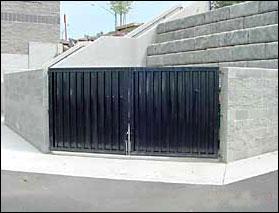 |
Enclosures do not have to be unsightly. This enclosure was designed to complement a new commercial office building. |
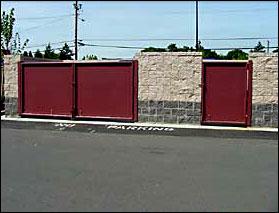 |
Another large, well-designed enclosure, this includes a smaller service door. It encourages employees and janitorial staff to put materials inside the enclosure because they do not have to open the heavier gates. |
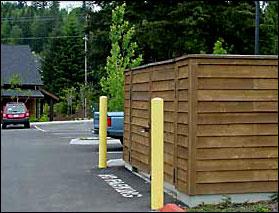 |
Built with the same cedar siding as the professional office building, this spacious enclosure looks good and works well. Posts provide extra protection. |
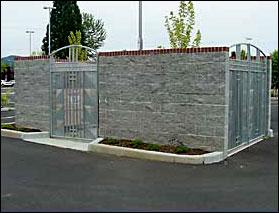 |
Using design elements from the main building, this enclosure sits in the middle of a parking lot. Service vehicles have good access to it. |
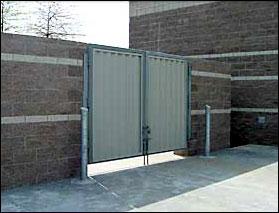 |
This large enclosure uses design elements from the new municipal building. |
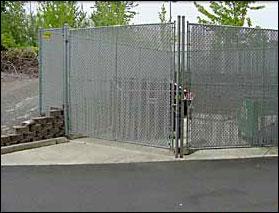 |
An example of a chain link and slat enclosure. |
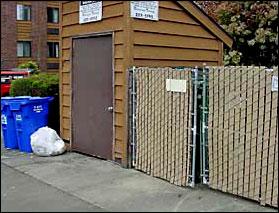 |
Too small for a group of strip mall tenants, this enclosure has been damaged. Tenants leave trash outside, creating an unsightly and potentially rat-infested area. Furthermore, it is not conducive to recycling. |
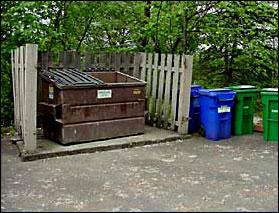 |
Small and unsightly, this enclosure does not meet the needs of this multifamily dwelling. |
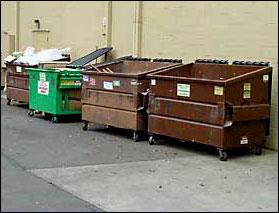 |
Approved before ZDO Section 1021 - this shopping mall places containers in full view of the street. It is unsightly for the residential development across the street, it promotes illegal dumping, and is prone to contamination of recyclables. |
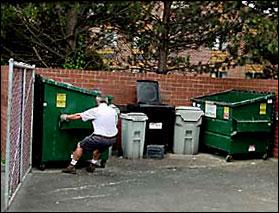 |
Don't try this at home! The collector is pulling out a 1,200 pound container that could have been picked up mechanically if the enclosure had been well designed. |
 Translate
Translate






